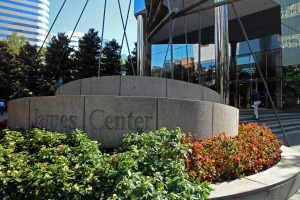
One of three James Center buildings downtown will soon lose its largest tenant. Photos by Evelyn Rupert.
Holding nine figures worth of debt, the lenders on three prominent downtown office towers seem to be preparing for the loss of one of the buildings’ biggest tenants.
A pair of loans backed by the James Center’s trio of towers totaling $150 million was transferred to a special servicer over the last few months, according to real estate tracking firm Trepp.
Richmond law giant McGuireWoods is set to vacate One James Center next year, leaving more than half the building vacant.
Special servicers often step in for a lender to try to work out a new strategy for payment on a loan when the note is threatened by a non-routine event like the loss of a major tenant.
It’s a step often triggered when there’s a high risk of default, said Andy Little, a principal with local real estate investment banking firm John B. Levy & Co.
A Trepp report shows that James Center has not defaulted on its loan payment. But it does say default is imminent because of the McGuireWoods move.
Little said the building owner and special servicer are likely in talks to restructure the debt.
“At this point, there is probably a negotiation going on between a borrower and a lender to get a loan modification that assumes they are going to lose the tenant and it will take 18 months to backfill the space,” Little said.
James Center One, Two and Three are owned by New York-based JEMB Realty.
McGuireWoods is scheduled to leave for the rising Gateway Plaza office tower next summer. The law firm occupies 257,000 square feet – largely on the second to ninth floors – of the building’s 489,000 square feet.
The property and its sister buildings have two creditors that stand to lose money if rent payments dry up. The buildings were initially issued a $150 million loan that was later split between a pair of commercial mortgage-backed securities (CMBS). One of those trusts holds $100 million in James Center debt, and the other has the remaining $50 million.
These loan pools can contain up to hundreds of other notes, but at $50 million and $100 million a piece, Little said the James Center debt is likely one of the biggest loans for each of the CMBS trusts.
The larger of the two loans was transferred to special servicer CWCapital Asset Management in July. A month later, CWCapital took over service of the $50 million note as well, Trepp records show.
James Center owner JEMB’s principal Joe Jerome declined to comment on any potential dealings with the servicer, citing a confidentiality agreement with the buildings’ lenders.
Two James Center, slightly larger than One James Center, is anchored by Wells Fargo. The third James Center building is about 347,000 square feet.
The three-building complex’s leasable real estate is about 90 percent occupied, said Cushman & Wakefield | Thalhimer broker Evan Magrill.
Refilling One James Center with a single tenant after McGuireWoods leaves would take a corporate headquarters relocation-type deal, Magrill said. It’s a prospect to look into, he said, but it isn’t one worth banking on.
“That is an opportunity that doesn’t exist elsewhere in Richmond: a big block of space in one section in that nice of a building,” he said. “But certainly if I were an owner, I wouldn’t wait for a large tenant like that. I would begin filling it up as soon as I can, even if it was one floor at a time.”
Tenants are currently paying about $20 per square foot, but Magrill said a larger tenant taking McGuireWoods’ space would likely get a lower rate.
Magrill said it would be difficult to forecast how long it would take to refill the building. But the entire downtown office market has seen about 250,000 square feet of positive absorption for the year.
“If all the new leases downtown and all of the expansions downtown happened in the James Center, it would happen in a year, but that’s not likely,” Magrill said.
A special servicer often comes into play with a loan in default and headed toward foreclosure. But Trepp analyst Sean Barrie said the lender isn’t necessarily coming to immediately collect on its security if the debt service payments dry up.
“At the end of the day, the special servicer is trying to get as much back to the loan as he can,” he said. “If that includes trying to refinance it, restructure it or sell it, those could all be options.”
Little said cases like this often end in some sort of loan restructure that splits the original loan into a safe, repayable loan based on the cash the building will generate without its anchor and a second, far more risky loan that is dependent solely on money the building could bring in from future tenants.
That’s not the most ideal scenario for a lender, Little said, but it means the building owner will keep pumping cash into marketing, refilling the space and preventing a foreclosure.
“It’s got a couple of pejorative terms, but I think the most optimistic is ‘hope note,’” Little said. “We’ve seen that structure work when a borrower says, ‘I’m underwater; however, I’m the best person to get the building back up so you don’t lose as much on this note as you otherwise would.’”
A deal, however, may not happen until after James Center’s lead tenant is settled in on the other side of 9th Street.
“I would say at this point – McGuireWoods still has eight or 10 months – it would be very proactive and unusual to get too far ahead of this,” Little said. “To me it seems like it’s got 12 months before it plays out.”

One of three James Center buildings downtown will soon lose its largest tenant. Photos by Evelyn Rupert.
Holding nine figures worth of debt, the lenders on three prominent downtown office towers seem to be preparing for the loss of one of the buildings’ biggest tenants.
A pair of loans backed by the James Center’s trio of towers totaling $150 million was transferred to a special servicer over the last few months, according to real estate tracking firm Trepp.
Richmond law giant McGuireWoods is set to vacate One James Center next year, leaving more than half the building vacant.
Special servicers often step in for a lender to try to work out a new strategy for payment on a loan when the note is threatened by a non-routine event like the loss of a major tenant.
It’s a step often triggered when there’s a high risk of default, said Andy Little, a principal with local real estate investment banking firm John B. Levy & Co.
A Trepp report shows that James Center has not defaulted on its loan payment. But it does say default is imminent because of the McGuireWoods move.
Little said the building owner and special servicer are likely in talks to restructure the debt.
“At this point, there is probably a negotiation going on between a borrower and a lender to get a loan modification that assumes they are going to lose the tenant and it will take 18 months to backfill the space,” Little said.
James Center One, Two and Three are owned by New York-based JEMB Realty.
McGuireWoods is scheduled to leave for the rising Gateway Plaza office tower next summer. The law firm occupies 257,000 square feet – largely on the second to ninth floors – of the building’s 489,000 square feet.
The property and its sister buildings have two creditors that stand to lose money if rent payments dry up. The buildings were initially issued a $150 million loan that was later split between a pair of commercial mortgage-backed securities (CMBS). One of those trusts holds $100 million in James Center debt, and the other has the remaining $50 million.
These loan pools can contain up to hundreds of other notes, but at $50 million and $100 million a piece, Little said the James Center debt is likely one of the biggest loans for each of the CMBS trusts.
The larger of the two loans was transferred to special servicer CWCapital Asset Management in July. A month later, CWCapital took over service of the $50 million note as well, Trepp records show.
James Center owner JEMB’s principal Joe Jerome declined to comment on any potential dealings with the servicer, citing a confidentiality agreement with the buildings’ lenders.
Two James Center, slightly larger than One James Center, is anchored by Wells Fargo. The third James Center building is about 347,000 square feet.
The three-building complex’s leasable real estate is about 90 percent occupied, said Cushman & Wakefield | Thalhimer broker Evan Magrill.
Refilling One James Center with a single tenant after McGuireWoods leaves would take a corporate headquarters relocation-type deal, Magrill said. It’s a prospect to look into, he said, but it isn’t one worth banking on.
“That is an opportunity that doesn’t exist elsewhere in Richmond: a big block of space in one section in that nice of a building,” he said. “But certainly if I were an owner, I wouldn’t wait for a large tenant like that. I would begin filling it up as soon as I can, even if it was one floor at a time.”
Tenants are currently paying about $20 per square foot, but Magrill said a larger tenant taking McGuireWoods’ space would likely get a lower rate.
Magrill said it would be difficult to forecast how long it would take to refill the building. But the entire downtown office market has seen about 250,000 square feet of positive absorption for the year.
“If all the new leases downtown and all of the expansions downtown happened in the James Center, it would happen in a year, but that’s not likely,” Magrill said.
A special servicer often comes into play with a loan in default and headed toward foreclosure. But Trepp analyst Sean Barrie said the lender isn’t necessarily coming to immediately collect on its security if the debt service payments dry up.
“At the end of the day, the special servicer is trying to get as much back to the loan as he can,” he said. “If that includes trying to refinance it, restructure it or sell it, those could all be options.”
Little said cases like this often end in some sort of loan restructure that splits the original loan into a safe, repayable loan based on the cash the building will generate without its anchor and a second, far more risky loan that is dependent solely on money the building could bring in from future tenants.
That’s not the most ideal scenario for a lender, Little said, but it means the building owner will keep pumping cash into marketing, refilling the space and preventing a foreclosure.
“It’s got a couple of pejorative terms, but I think the most optimistic is ‘hope note,’” Little said. “We’ve seen that structure work when a borrower says, ‘I’m underwater; however, I’m the best person to get the building back up so you don’t lose as much on this note as you otherwise would.’”
A deal, however, may not happen until after James Center’s lead tenant is settled in on the other side of 9th Street.
“I would say at this point – McGuireWoods still has eight or 10 months – it would be very proactive and unusual to get too far ahead of this,” Little said. “To me it seems like it’s got 12 months before it plays out.”




